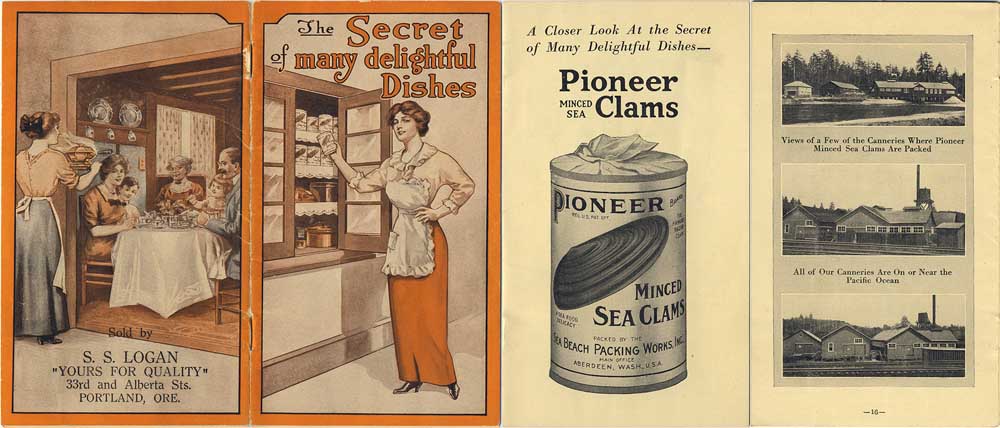Taste of winter: Clam recipes stand the test of time
Published 12:00 pm Sunday, December 4, 2022

- Pioneer Packing Co., like many seafood firms of its era, produced free recipe booklets to promote its products.
Clams of many varieties have long been a seafood staple on the Northwest Coast. Although clamming remains on hiatus while an uptick in toxic domoic acid dissipates, local people with clams in the freezer may enjoy making a century-old recipe outlined here.
Pioneer Packing
Peter F. Halferty is often given credit for the birth of clam canning on the West Coast when he founded what soon became known as Pioneer Packing Co. in 1894.
Historian Katherine Johnson describes Halferty’s desperation to feed his family of seven children. He began selling his own home-canned clams in Astoria — and they quickly became a hit.
Halferty began growing his business so that, “[b]y the turn of the century, Halferty had transformed a domestic canning process into a successful regional venture.”
Warrenton Clam
Warrenton Clam Co. was another figure in the razor clam canning industry on the Washington and Oregon coast for many years.
A 1917 edition of Western Canner and Packer detailed the company’s article of incorporation being filed in Astoria: “The incorporators are Warren C. Lester, Sigurd Sigurdson, Gunnar Siguardson and Fred B. Sigurdson, and the capital stock is $25,000. The object of the company is to engage in canning clams in Warrenton.”
In addition to Warrenton, the firm eventually had canneries in Nahcotta, North Cove and Copalis Beach, Washington, and Cordova, Alaska. Nahcotta-based Wiegardt Brothers and the Sigurdson Brothers appear to have been collaborative partners in this venture.
From its origin in the late-1910s to its eventual closure around the outset of World War II, Warrenton Clam Co. produced dozens of recipes for its customers to make the best use of its product.
One pamphlet, labeled “Warrenton Clams: Sixteen Recipes; Aristocrat for the Dinner Table,” offers up a wide range of opportunities for domestic chefs to turn their canned clams into a delicacy.
The brochure explains that the Pacific Northwest is ideal for cultivating the best clams. Across Oregon, Washington and Alaska, “the sea breeze and the salt tang that puts a zest into the air has added appetizing flavor and healthful cleanliness to these delicacies.”
Warrenton Clam Co. products could be purchased in two varieties, all “for the convenience of the housewife”: whole razor clams that had been cleaned and dressed; or minced clams that had been chopped and canned.
I had to put one of these recipes to the test, so I recreated Warrenton Clam Co.’s “Clam Novelty.” The recipe is below:
Clam Novelty
Ingredients
• Canned clams (whole, not minced)
• One egg
• 1 cup milk
• 1 cup rice
• 1/4 teaspoon salt
• 1/8 teaspoon paprika
• 1 Tablespoon onion juice
Cheese sauce
• Mozzarella cheese
• Scallions
• Worcestershire sauce
• Cajun spice blend
• Cream cheese
Preparation
Drain one can of Warrenton whole clams and cut into pieces. Beat one egg and add 1 cup milk, 1 cup cooked rice, 1/4 teaspoon salt, 1/8 teaspoon paprika, 1 teaspoon onion juice and clams.
Turn mixture into buttered ramekins. Place these in a pan of hot water and bake in a moderate oven, 350 to 400 degrees Fahrenheit until mixture is firm. Turn molds onto a hot platter and serve with cheese sauce.
Overall, the recipe was extremely simple to make. With four simple steps, the hardest part was having to wait the 40 minutes it took for the ramekins to firm up.
My roommate, Maddi, was apprehensive at trying a 1930s seafood-based recipe. Their description upon tasting it was, “It’s like clam chowder, but in souffle form.”
After almost 100 years, Warrenton Clam Co.’s Clam Novelty stood the test of time. I’m looking forward to uncovering more hidden gems that have made our region’s seafood so iconic.









